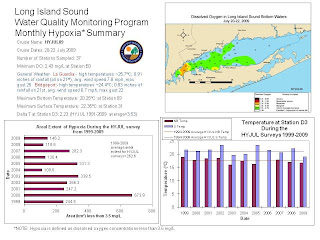Half as Bad?

The Connecticut DEP’s water quality survey from last week not surprisingly shows that hypoxia is getting worse in Long Island Sound as the weather warms up.
Five of the 37 places where they took measurements were below 3.5 milligrams per liter and two were below 3.
Last year at the same time, 10 were below 3.5 and five below 3.
So it looks like the cool June has left the Sound only half as bad this year as last.
This year, 56.4 square miles are below 3.5. The average from 1999 through 2009 was 101.4 (the Sound is about 1,200 square miles in all).
It’s worth keeping in mind though that the third week of July is often when conditions get really bad and stay there for weeks on end. In 1987, for example, it’s when all he big fish kills took place. So compared to that, we’re doing much better.
But don’t take too much solace. Most of it can be attributed to the weather: hot and humid means terrible hypoxia; cool and breeze means not so bad.
Here’s what the DEP sent out this afternoon, verbatim:
The 2009 July Hypoxia Survey was conducted 20-22 July. Thirty-seven stations were sampled. Bottom water dissolved oxygen concentrations fell below 4.8 mg/L at 24 stations with five of those stations falling below 3.5 mg/L and two stations falling below 3.0 mg/L. In 2008, 18 stations had concentrations below 4.8 mg/L; 10 of those were below 3.5 mg/L and five were below 3.0 mg/L. The lowest concentration was observed at Station B3 (2.43 mg/L), which decreased from 3.3 mg/L measured on 7/20/09 during the IEC survey . Concentrations at A4 increased slightly from those measured during the IEC survey to 3.5 mg/L from 3.2 mg/L. The area of bottom water affected by hypoxia (DO <3.5 mg/L) is 56.4 square miles (146.2 sq. km). The area with DO concentrations less than 3.0 mg/L is 28.1 square miles (72.8 sq km). The average area affected by hypoxia from 1999-2009 was 101.4 sq mi (262.6 sq km). While this is greater than the 2008 area, it is important to note that 11 stations were not sampled in 2008, reducing the areal estimate.
Here's the report from earlier this month.



0 Comments:
Post a Comment
<< Home